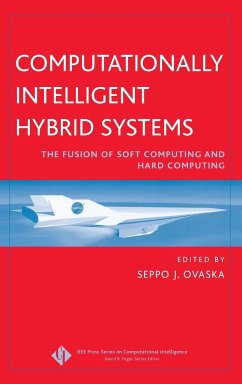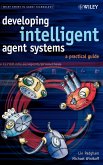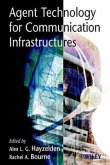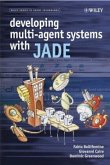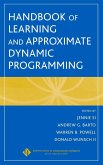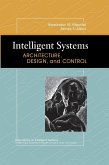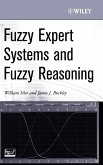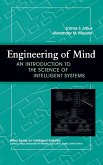Intelligent Hybrid Systems
Hrsg. v. Seppo J. Ovaska
Intelligent Hybrid Systems
Hrsg. v. Seppo J. Ovaska
- Gebundenes Buch
- Merkliste
- Auf die Merkliste
- Bewerten Bewerten
- Teilen
- Produkt teilen
- Produkterinnerung
- Produkterinnerung
Soft computing is an emerging collection of methodologies that exploit tolerances for imprecision, uncertainty, and partial truth to achieve robustness, tractability, and low total cost. Hard computing solutions are usually more straightforward to analyze, and feature more predictable behavior and stability. This in-depth resource lucidly explains the fusion of soft computing and hard computing methodologies, and includes a comprehensive set of real-world applications.
This uniquely crafted work combines the experience of many internationally recognized experts in the soft- and…mehr
Andere Kunden interessierten sich auch für
![Developing Intelligent Agent Systems Developing Intelligent Agent Systems]() Michael WinikoffDeveloping Intelligent Agent Systems87,99 €
Michael WinikoffDeveloping Intelligent Agent Systems87,99 €![Agent Technology for Communication Infrastructures Agent Technology for Communication Infrastructures]() Alex L. G. Hayzelden / Rachel A. Bourne (Hgg.)Agent Technology for Communication Infrastructures152,99 €
Alex L. G. Hayzelden / Rachel A. Bourne (Hgg.)Agent Technology for Communication Infrastructures152,99 €![Developing Multi-Agent Systems with JADE Developing Multi-Agent Systems with JADE]() Fabio Luigi BellifemineDeveloping Multi-Agent Systems with JADE130,99 €
Fabio Luigi BellifemineDeveloping Multi-Agent Systems with JADE130,99 €![Handbook of Learning and Approximate Dynamic Programming Handbook of Learning and Approximate Dynamic Programming]() Handbook of Learning and Approximate Dynamic Programming194,99 €
Handbook of Learning and Approximate Dynamic Programming194,99 €![Intelligent Systems Intelligent Systems]() Alexander M. MeystelIntelligent Systems173,99 €
Alexander M. MeystelIntelligent Systems173,99 €![Fuzzy Expert Systems and Fuzzy Reasoning Fuzzy Expert Systems and Fuzzy Reasoning]() William SilerFuzzy Expert Systems and Fuzzy Reasoning180,99 €
William SilerFuzzy Expert Systems and Fuzzy Reasoning180,99 €![Engineering of Mind Engineering of Mind]() James S. AlbusEngineering of Mind189,99 €
James S. AlbusEngineering of Mind189,99 €-
-
-
Soft computing is an emerging collection of methodologies that exploit tolerances for imprecision, uncertainty, and partial truth to achieve robustness, tractability, and low total cost. Hard computing solutions are usually more straightforward to analyze, and feature more predictable behavior and stability. This in-depth resource lucidly explains the fusion of soft computing and hard computing methodologies, and includes a comprehensive set of real-world applications.
This uniquely crafted work combines the experience of many internationally recognized experts in the soft- and hard-computing research worlds to present practicing engineers with the broadest possible array of methodologies for developing innovative and competitive solutions to real-world problems. Each of the chapters illustrates the wide-ranging applicability of the fusion concept in such critical areas as
_ Computer security and data mining
_ Electrical power systems and large-scale plants
_ Motor drives and tool wear monitoring
_ User interfaces and the World Wide Web
_ Aerospace and robust control
This must-have guide for practicing engineers, researchers, and R&D managers who wish to create or understand computationally intelligent hybrid systems is also an excellent primary source for graduate courses in soft computing, engineering applications of artificial intelligence, and related topics.
Hinweis: Dieser Artikel kann nur an eine deutsche Lieferadresse ausgeliefert werden.
This uniquely crafted work combines the experience of many internationally recognized experts in the soft- and hard-computing research worlds to present practicing engineers with the broadest possible array of methodologies for developing innovative and competitive solutions to real-world problems. Each of the chapters illustrates the wide-ranging applicability of the fusion concept in such critical areas as
_ Computer security and data mining
_ Electrical power systems and large-scale plants
_ Motor drives and tool wear monitoring
_ User interfaces and the World Wide Web
_ Aerospace and robust control
This must-have guide for practicing engineers, researchers, and R&D managers who wish to create or understand computationally intelligent hybrid systems is also an excellent primary source for graduate courses in soft computing, engineering applications of artificial intelligence, and related topics.
Hinweis: Dieser Artikel kann nur an eine deutsche Lieferadresse ausgeliefert werden.
Produktdetails
- Produktdetails
- IEEE Series on Computational Intelligence
- Verlag: Wiley & Sons
- 1. Auflage
- Seitenzahl: 440
- Erscheinungstermin: 1. November 2004
- Englisch
- Abmessung: 240mm x 161mm x 28mm
- Gewicht: 740g
- ISBN-13: 9780471476689
- ISBN-10: 0471476684
- Artikelnr.: 12987240
- Herstellerkennzeichnung
- Libri GmbH
- Europaallee 1
- 36244 Bad Hersfeld
- gpsr@libri.de
- IEEE Series on Computational Intelligence
- Verlag: Wiley & Sons
- 1. Auflage
- Seitenzahl: 440
- Erscheinungstermin: 1. November 2004
- Englisch
- Abmessung: 240mm x 161mm x 28mm
- Gewicht: 740g
- ISBN-13: 9780471476689
- ISBN-10: 0471476684
- Artikelnr.: 12987240
- Herstellerkennzeichnung
- Libri GmbH
- Europaallee 1
- 36244 Bad Hersfeld
- gpsr@libri.de
SEPPO J. OVASKA, DSc (Tech), is a professor in the Department of Electrical and Communications Engineering at Helsinki University of Technology, Finland. He is a senior member of the IEEE, and has published more than 180 papers in peer-reviewed journals and international conferences.
Contributors xv
Foreword xvii
David B. Fogel
Preface xix
Editor's Introduction to Chapter 1 1
1 Introduction to Fusion of Soft Computing and Hard Computing 5
Seppo J. Ovaska
1.1 Introduction 5
1.1.1 Soft Computing 5a
1.1.2 Fusion of Soft-Computing and Hard-Computing Methodologies 7
1.2 Structural Categories 9
1.2.1 Soft Computing and Hard Computing Are Isolated from Each Other 10
1.2.2 Soft Computing and Hard Computing Are Connected in Parallel 11
1.2.3 Soft Computing with Hard-Computing Feedback and Hard Computing with
Soft-Computing Feedback 12
1.2.4 Soft Computing is Cascaded with Hard Computing or Hard Computing is
Cascaded with Soft Computing 12
1.2.5 Soft-Computing-Designed Hard Computing and Hard-Computing-Designed
Soft Computing 13
1.2.6 Hard-Computing-Augmented Soft Computing and Soft-Computing-Augmented
Hard Computing 14
1.2.7 Hard-Computing-Assisted Soft Computing and Soft-Computing-Assisted
Hard Computing 15
1.2.8 Supplementary Categories 16
1.2.9 General Soft-Computing and Hard-Computing Mapping Functions 19
1.3 Characteristic Features 19
1.3.1 Proportional Integral Derivative Controllers 20
1.3.2 Physical Models 20
1.3.3 Optimization Utilizing Local Information 21
1.3.4 General Parameter Adaptation Algorithm 22
1.3.5 Stochastic System Simulators 22
1.3.6 Discussion and Extended Fusion Schemes 22
1.4 Characterization of Hybrid Applications 24
1.5 Conclusions and Discussion 25
References 27
Editor's Introduction to Chapter 2 31
2 General Model for Large-Scale Plant Application 35
Akimoto Kamiya
2.1 Introduction 35
2.2 Control System Architecture 36
2.3 Forecasting of Market Demand 37
2.4 Scheduling of Processes 39
2.4.1 Problem Decomposition 39
2.4.2 Hybrid Genetic Algorithms 42
2.4.3 Multiobjective Optimization 43
2.5 Supervisory Control 45
2.6 Local Control 47
2.7 General Fusion Model and Fusion Categories 49
2.8 Conclusions 51
References 51
Editor's Introduction to Chapter 3 57
3 Adaptive Flight Control: Soft Computing with Hard Constraints 61
Richard E. Saeks
3.1 Introduction 61
3.2 The Adaptive Control Algorithms 62
3.2.1 Adaptive Dynamic Programming 63
3.2.2 Neural Adaptive Control 64
3.3 Flight Control 67
3.4 X-43A-LS Autolander 68
3.5 LOFLYTEw Optimal Control 73
3.6 LOFLYTEw Stability Augmentation 76
3.7 Design for Uncertainty with Hard Constraints 82
3.8 Fusion of Soft Computing and Hard Computing 85
3.9 Conclusions 85
References 86
Editor's Introduction to Chapter 4 89
4 Sensorless Control of Switched Reluctance Motors 93
Adrian David Cheok
4.1 Introduction 93
4.2 Fuzzy Logic Model 95
4.2.1 Measurement of Flux Linkage Characteristics 95
4.2.2 Training and Validation of Fuzzy Model 97
4.3 Accuracy Enhancement Algorithms 101
4.3.1 Soft-Computing-Based Optimal Phase Selection 102
4.3.2 Hard-Computing-Based On-Line Resistance Estimation 104
4.3.3 Polynomial Predictive Filtering 105
4.4 Simulation Algorithm and Results 108
4.5 Hardware and Software Implementation 109
4.5.1 Hardware Configuration 109
4.5.2 Software Implementation 110
4.6 Experimental Results 111
4.6.1 Acceleration from Zero Speed 112
4.6.2 Low-Current Low-Speed Test 113
4.6.3 High-Speed Test 114
4.6.4 Test of Step Change of Load 118
4.7 Fusion of Soft Computing and Hard Computing 119
4.8 Conclusion and Discussion 122
References 122
Editor's Introduction to Chapter 5 125
5 Estimation of Uncertainty Bounds for Linear and Nonlinear Robust Control
129
Gregory D. Buckner
5.1 Introduction 129
5.2 Robust Control of Active Magnetic Bearings 130
5.2.1 Active Magnetic Bearing Test Rig 132
5.3 Nominal H1 Control of the AMB Test Rig 133
5.3.1 Parametric System Identification 133
5.3.2 Uncertainty Bound Specification 135
5.3.3 Nominal H1 Control: Experimental Results 137
5.4 Estimating Modeling Uncertainty for H1 Control of the AMB Test Rig 138
5.4.1 Model Error Modeling 140
5.4.2 Intelligent Model Error Identification 141
5.4.3 Uncertainty Bound Specification 146
5.4.4 Identified H1 Control: Experimental Results 147
5.5 Nonlinear Robust Control of the AMB Test Rig 148
5.5.1 Nominal Sliding Mode Control of the AMB Test Rig 148
5.5.2 Nominal SMC: Experimental Results 150
5.6 Estimating Model Uncertainty for SMC of the AMB Test Rig 151
5.6.1 Intelligent System Identification 151
5.6.2 Intelligent Model Error Identification 155
5.6.3 Intelligent SMC: Experimental Results 156
5.7 Fusion of Soft Computing and Hard Computing 159
5.8 Conclusion 162
References 162
Editor's Introduction to Chapter 6 165
6 Indirect On-Line Tool Wear Monitoring 169
Bernhard Sick
6.1 Introduction 169
6.2 Problem Description and Monitoring Architecture 172
6.3 State of the Art 176
6.3.1 Monitoring Techniques Based on Analytical Models 176
6.3.2 Monitoring Techniques Based on Neural Networks 178
6.3.3 Monitoring Techniques Based on Fusion of Physical and Neural Network
Models 181
6.4 New Solution 184
6.4.1 Solution Outline 184
6.4.2 Physical Force Model at Digital Preprocessing Level 185
6.4.3 Dynamic Neural Network at Wear Model Level 187
6.5 Experimental Results 189
6.6 Fusion of Soft Computing and Hard Computing 192
6.7 Summary and Conclusions 194
References 195
Editor's Introduction to Chapter 7 199
7 Predictive Filtering Methods for Power Systems Applications 203
Seppo J. Ovaska
7.1 Introduction 203
7.2 Multiplicative General-Parameter Filtering 205
7.3 Genetic Algorithm for Optimizing Filter Tap Cross-Connections 207
7.4 Design of Multiplierless Basis Filters by Evolutionary Programming 211
7.5 Predictive Filters for Zero-Crossings Detector 213
7.5.1 Single 60-Hz Sinusoid Corrupted by Noise 213
7.5.2 Sequence of 49-, 50-, and 51-Hz Sinusoids Corrupted by Noise 217
7.5.3 Discussion of Zero-Crossings Detection Application 222
7.6 Predictive Filters for Current Reference Generators 223
7.6.1 Sequence of 49-, 50-, and 51-Hz Noisy Sinusoids 225
7.6.2 Sequence of 49-, 50-, and 51-Hz Noisy Sinusoids Corrupted by
Harmonics 229
7.6.3 Artificial Current Signal Corrupted by Odd Harmonics 230
7.6.4 Discussion of Current Reference Generation Application 232
7.7 Fusion of Soft Computing and Hard Computing 233
7.8 Conclusion 234
References 237
Appendix 7.1: Coefficients of 50-Hz Sinusoid-Predictive FIR Filters 239
Editor's Introduction to Chapter 8 241
8 Intrusion Detection for Computer Security 245
Sung-Bae Cho and Sang-Jun Han
8.1 Introduction 245
8.2 Related Works 247
8.2.1 Neural Computing 248
8.2.2 Genetic Computing 249
8.2.3 Fuzzy Logic 251
8.2.4 Probabilistic Reasoning 253
8.3 Intrusion Detection with Hybrid Techniques 253
8.3.1 Overview 254
8.3.2 Preprocessing with Self-Organizing Map 254
8.3.3 Behavior Modeling with Hidden Markov Models 256
8.3.4 Multiple Models Fusion by Fuzzy Logic 259
8.4 Experimental Results 261
8.4.1 Preprocessing 261
8.4.2 Modeling and Intrusion Detection 263
8.5 Fusion of Soft Computing and Hard Computing 267
8.6 Concluding Remarks 268
References 270
Editor's Introduction to Chapter 9 273
9 Emotion Generating Method On Human-Computer Interfaces 277
Kazuya Mera and Takumi Ichimura
9.1 Introduction 277
9.2 Emotion Generating Calculations Method 279
9.2.1 Favorite Value Database 280
9.2.2 Calculation Pleasure/Displeasure for an Event 282
9.2.3 Favorite Value of Modified Element 284
9.2.4 Experimental Result 285
9.2.5 Complicated Emotion Allocating Method 286
9.2.6 Dependency Among Emotion Groups 294
9.2.7 Example of Complicated Emotion Allocating Method 296
9.2.8 Experimental Results 297
9.3 Emotion-Oriented Interaction Systems 298
9.3.1 Facial Expression Generating Method by Neural Network 298
9.3.2 Assign Rules to the Facial Expressions 301
9.4 Applications of Emotion-Oriented Interaction Systems 302
9.4.1 JavaFaceMail 302
9.4.2 JavaFaceChat 307
9.5 Fusion of Soft Computing and Hard Computing 308
9.6 Conclusion 310
References 311
Editor's Introduction to Chapter 10 313
10 Introduction to Scientific Data Mining: Direct Kernel Methods and
Applications 317
Mark J. Embrechts, Boleslaw Szymanski, and Karsten Sternickel
10.1 Introduction 317
10.2 What is Data Mining? 318
10.2.1 Introduction to Data Mining 318
10.2.2 Scientific Data Mining 320
10.2.3 The Data Mining Process 321
10.2.4 Data Mining Methods and Techniques 322
10.3 Basic Definitions for Data Mining 323
10.3.1 The MetaNeural Data Format 323
10.3.2 The "Standard Data Mining Problem" 326
10.3.3 Predictive Data Mining 329
10.3.4 Metrics for Assessing Model Quality 333
10.4 Introduction to Direct Kernel Methods 335
10.4.1 Data Mining and Machine Learning Dilemmas for Real-World Data 335
10.4.2 Regression Models Based on the Data Kernel 338
10.4.3 Kernel Transformations 339
10.4.4 Dealing with Bias: Centering the Kernel 340
10.5 Direct Kernel Ridge Regression 342
10.5.1 Overview 342
10.5.2 Choosing the Ridge Parameter 343
10.6 Case Study #1: Predicting the Binding Energy for Amino Acids 344
10.7 Case Study #2: Predicting the Region of Origin for Italian Olive Oils
346
10.8 Case Study #3: Predicting Ischemia from Magnetocardiography 350
10.8.1 Introduction to Magnetocardiography 350
10.8.2 Data Acquisition and Preprocessing 351
10.8.3 Predictive Modeling for Binary Classification of Magnetocardiograms
351
10.8.4 Feature Selection 358
10.9 Fusion of Soft Computing and Hard Computing 359
10.10 Conclusions 359
References 360
Editor's Introduction to Chapter 11 363
11 World Wide Web Usage Mining 367
Ajith Abraham
11.1 Introduction 367
11.2 Daily and Hourly Web Usage Clustering 372
11.2.1 Ant Colony Optimization 372
11.2.2 Fuzzy Clustering Algorithm 374
11.2.3 Self-Organizing Map 376
11.2.4 Analysis of Web Data Clusters 377
11.3 Daily and Hourly Web Usage Analysis 378
11.3.1 Linear Genetic Programming 379
11.3.2 Fuzzy Inference Systems 382
11.3.3 Experimentation Setup, Training, and Performance Evaluation 387
11.4 Fusion of Soft Computing and Hard Computing 389
11.5 Conclusions 393
References 394
Index 397
About the Editor 409
Foreword xvii
David B. Fogel
Preface xix
Editor's Introduction to Chapter 1 1
1 Introduction to Fusion of Soft Computing and Hard Computing 5
Seppo J. Ovaska
1.1 Introduction 5
1.1.1 Soft Computing 5a
1.1.2 Fusion of Soft-Computing and Hard-Computing Methodologies 7
1.2 Structural Categories 9
1.2.1 Soft Computing and Hard Computing Are Isolated from Each Other 10
1.2.2 Soft Computing and Hard Computing Are Connected in Parallel 11
1.2.3 Soft Computing with Hard-Computing Feedback and Hard Computing with
Soft-Computing Feedback 12
1.2.4 Soft Computing is Cascaded with Hard Computing or Hard Computing is
Cascaded with Soft Computing 12
1.2.5 Soft-Computing-Designed Hard Computing and Hard-Computing-Designed
Soft Computing 13
1.2.6 Hard-Computing-Augmented Soft Computing and Soft-Computing-Augmented
Hard Computing 14
1.2.7 Hard-Computing-Assisted Soft Computing and Soft-Computing-Assisted
Hard Computing 15
1.2.8 Supplementary Categories 16
1.2.9 General Soft-Computing and Hard-Computing Mapping Functions 19
1.3 Characteristic Features 19
1.3.1 Proportional Integral Derivative Controllers 20
1.3.2 Physical Models 20
1.3.3 Optimization Utilizing Local Information 21
1.3.4 General Parameter Adaptation Algorithm 22
1.3.5 Stochastic System Simulators 22
1.3.6 Discussion and Extended Fusion Schemes 22
1.4 Characterization of Hybrid Applications 24
1.5 Conclusions and Discussion 25
References 27
Editor's Introduction to Chapter 2 31
2 General Model for Large-Scale Plant Application 35
Akimoto Kamiya
2.1 Introduction 35
2.2 Control System Architecture 36
2.3 Forecasting of Market Demand 37
2.4 Scheduling of Processes 39
2.4.1 Problem Decomposition 39
2.4.2 Hybrid Genetic Algorithms 42
2.4.3 Multiobjective Optimization 43
2.5 Supervisory Control 45
2.6 Local Control 47
2.7 General Fusion Model and Fusion Categories 49
2.8 Conclusions 51
References 51
Editor's Introduction to Chapter 3 57
3 Adaptive Flight Control: Soft Computing with Hard Constraints 61
Richard E. Saeks
3.1 Introduction 61
3.2 The Adaptive Control Algorithms 62
3.2.1 Adaptive Dynamic Programming 63
3.2.2 Neural Adaptive Control 64
3.3 Flight Control 67
3.4 X-43A-LS Autolander 68
3.5 LOFLYTEw Optimal Control 73
3.6 LOFLYTEw Stability Augmentation 76
3.7 Design for Uncertainty with Hard Constraints 82
3.8 Fusion of Soft Computing and Hard Computing 85
3.9 Conclusions 85
References 86
Editor's Introduction to Chapter 4 89
4 Sensorless Control of Switched Reluctance Motors 93
Adrian David Cheok
4.1 Introduction 93
4.2 Fuzzy Logic Model 95
4.2.1 Measurement of Flux Linkage Characteristics 95
4.2.2 Training and Validation of Fuzzy Model 97
4.3 Accuracy Enhancement Algorithms 101
4.3.1 Soft-Computing-Based Optimal Phase Selection 102
4.3.2 Hard-Computing-Based On-Line Resistance Estimation 104
4.3.3 Polynomial Predictive Filtering 105
4.4 Simulation Algorithm and Results 108
4.5 Hardware and Software Implementation 109
4.5.1 Hardware Configuration 109
4.5.2 Software Implementation 110
4.6 Experimental Results 111
4.6.1 Acceleration from Zero Speed 112
4.6.2 Low-Current Low-Speed Test 113
4.6.3 High-Speed Test 114
4.6.4 Test of Step Change of Load 118
4.7 Fusion of Soft Computing and Hard Computing 119
4.8 Conclusion and Discussion 122
References 122
Editor's Introduction to Chapter 5 125
5 Estimation of Uncertainty Bounds for Linear and Nonlinear Robust Control
129
Gregory D. Buckner
5.1 Introduction 129
5.2 Robust Control of Active Magnetic Bearings 130
5.2.1 Active Magnetic Bearing Test Rig 132
5.3 Nominal H1 Control of the AMB Test Rig 133
5.3.1 Parametric System Identification 133
5.3.2 Uncertainty Bound Specification 135
5.3.3 Nominal H1 Control: Experimental Results 137
5.4 Estimating Modeling Uncertainty for H1 Control of the AMB Test Rig 138
5.4.1 Model Error Modeling 140
5.4.2 Intelligent Model Error Identification 141
5.4.3 Uncertainty Bound Specification 146
5.4.4 Identified H1 Control: Experimental Results 147
5.5 Nonlinear Robust Control of the AMB Test Rig 148
5.5.1 Nominal Sliding Mode Control of the AMB Test Rig 148
5.5.2 Nominal SMC: Experimental Results 150
5.6 Estimating Model Uncertainty for SMC of the AMB Test Rig 151
5.6.1 Intelligent System Identification 151
5.6.2 Intelligent Model Error Identification 155
5.6.3 Intelligent SMC: Experimental Results 156
5.7 Fusion of Soft Computing and Hard Computing 159
5.8 Conclusion 162
References 162
Editor's Introduction to Chapter 6 165
6 Indirect On-Line Tool Wear Monitoring 169
Bernhard Sick
6.1 Introduction 169
6.2 Problem Description and Monitoring Architecture 172
6.3 State of the Art 176
6.3.1 Monitoring Techniques Based on Analytical Models 176
6.3.2 Monitoring Techniques Based on Neural Networks 178
6.3.3 Monitoring Techniques Based on Fusion of Physical and Neural Network
Models 181
6.4 New Solution 184
6.4.1 Solution Outline 184
6.4.2 Physical Force Model at Digital Preprocessing Level 185
6.4.3 Dynamic Neural Network at Wear Model Level 187
6.5 Experimental Results 189
6.6 Fusion of Soft Computing and Hard Computing 192
6.7 Summary and Conclusions 194
References 195
Editor's Introduction to Chapter 7 199
7 Predictive Filtering Methods for Power Systems Applications 203
Seppo J. Ovaska
7.1 Introduction 203
7.2 Multiplicative General-Parameter Filtering 205
7.3 Genetic Algorithm for Optimizing Filter Tap Cross-Connections 207
7.4 Design of Multiplierless Basis Filters by Evolutionary Programming 211
7.5 Predictive Filters for Zero-Crossings Detector 213
7.5.1 Single 60-Hz Sinusoid Corrupted by Noise 213
7.5.2 Sequence of 49-, 50-, and 51-Hz Sinusoids Corrupted by Noise 217
7.5.3 Discussion of Zero-Crossings Detection Application 222
7.6 Predictive Filters for Current Reference Generators 223
7.6.1 Sequence of 49-, 50-, and 51-Hz Noisy Sinusoids 225
7.6.2 Sequence of 49-, 50-, and 51-Hz Noisy Sinusoids Corrupted by
Harmonics 229
7.6.3 Artificial Current Signal Corrupted by Odd Harmonics 230
7.6.4 Discussion of Current Reference Generation Application 232
7.7 Fusion of Soft Computing and Hard Computing 233
7.8 Conclusion 234
References 237
Appendix 7.1: Coefficients of 50-Hz Sinusoid-Predictive FIR Filters 239
Editor's Introduction to Chapter 8 241
8 Intrusion Detection for Computer Security 245
Sung-Bae Cho and Sang-Jun Han
8.1 Introduction 245
8.2 Related Works 247
8.2.1 Neural Computing 248
8.2.2 Genetic Computing 249
8.2.3 Fuzzy Logic 251
8.2.4 Probabilistic Reasoning 253
8.3 Intrusion Detection with Hybrid Techniques 253
8.3.1 Overview 254
8.3.2 Preprocessing with Self-Organizing Map 254
8.3.3 Behavior Modeling with Hidden Markov Models 256
8.3.4 Multiple Models Fusion by Fuzzy Logic 259
8.4 Experimental Results 261
8.4.1 Preprocessing 261
8.4.2 Modeling and Intrusion Detection 263
8.5 Fusion of Soft Computing and Hard Computing 267
8.6 Concluding Remarks 268
References 270
Editor's Introduction to Chapter 9 273
9 Emotion Generating Method On Human-Computer Interfaces 277
Kazuya Mera and Takumi Ichimura
9.1 Introduction 277
9.2 Emotion Generating Calculations Method 279
9.2.1 Favorite Value Database 280
9.2.2 Calculation Pleasure/Displeasure for an Event 282
9.2.3 Favorite Value of Modified Element 284
9.2.4 Experimental Result 285
9.2.5 Complicated Emotion Allocating Method 286
9.2.6 Dependency Among Emotion Groups 294
9.2.7 Example of Complicated Emotion Allocating Method 296
9.2.8 Experimental Results 297
9.3 Emotion-Oriented Interaction Systems 298
9.3.1 Facial Expression Generating Method by Neural Network 298
9.3.2 Assign Rules to the Facial Expressions 301
9.4 Applications of Emotion-Oriented Interaction Systems 302
9.4.1 JavaFaceMail 302
9.4.2 JavaFaceChat 307
9.5 Fusion of Soft Computing and Hard Computing 308
9.6 Conclusion 310
References 311
Editor's Introduction to Chapter 10 313
10 Introduction to Scientific Data Mining: Direct Kernel Methods and
Applications 317
Mark J. Embrechts, Boleslaw Szymanski, and Karsten Sternickel
10.1 Introduction 317
10.2 What is Data Mining? 318
10.2.1 Introduction to Data Mining 318
10.2.2 Scientific Data Mining 320
10.2.3 The Data Mining Process 321
10.2.4 Data Mining Methods and Techniques 322
10.3 Basic Definitions for Data Mining 323
10.3.1 The MetaNeural Data Format 323
10.3.2 The "Standard Data Mining Problem" 326
10.3.3 Predictive Data Mining 329
10.3.4 Metrics for Assessing Model Quality 333
10.4 Introduction to Direct Kernel Methods 335
10.4.1 Data Mining and Machine Learning Dilemmas for Real-World Data 335
10.4.2 Regression Models Based on the Data Kernel 338
10.4.3 Kernel Transformations 339
10.4.4 Dealing with Bias: Centering the Kernel 340
10.5 Direct Kernel Ridge Regression 342
10.5.1 Overview 342
10.5.2 Choosing the Ridge Parameter 343
10.6 Case Study #1: Predicting the Binding Energy for Amino Acids 344
10.7 Case Study #2: Predicting the Region of Origin for Italian Olive Oils
346
10.8 Case Study #3: Predicting Ischemia from Magnetocardiography 350
10.8.1 Introduction to Magnetocardiography 350
10.8.2 Data Acquisition and Preprocessing 351
10.8.3 Predictive Modeling for Binary Classification of Magnetocardiograms
351
10.8.4 Feature Selection 358
10.9 Fusion of Soft Computing and Hard Computing 359
10.10 Conclusions 359
References 360
Editor's Introduction to Chapter 11 363
11 World Wide Web Usage Mining 367
Ajith Abraham
11.1 Introduction 367
11.2 Daily and Hourly Web Usage Clustering 372
11.2.1 Ant Colony Optimization 372
11.2.2 Fuzzy Clustering Algorithm 374
11.2.3 Self-Organizing Map 376
11.2.4 Analysis of Web Data Clusters 377
11.3 Daily and Hourly Web Usage Analysis 378
11.3.1 Linear Genetic Programming 379
11.3.2 Fuzzy Inference Systems 382
11.3.3 Experimentation Setup, Training, and Performance Evaluation 387
11.4 Fusion of Soft Computing and Hard Computing 389
11.5 Conclusions 393
References 394
Index 397
About the Editor 409
Contributors xv
Foreword xvii
David B. Fogel
Preface xix
Editor's Introduction to Chapter 1 1
1 Introduction to Fusion of Soft Computing and Hard Computing 5
Seppo J. Ovaska
1.1 Introduction 5
1.1.1 Soft Computing 5a
1.1.2 Fusion of Soft-Computing and Hard-Computing Methodologies 7
1.2 Structural Categories 9
1.2.1 Soft Computing and Hard Computing Are Isolated from Each Other 10
1.2.2 Soft Computing and Hard Computing Are Connected in Parallel 11
1.2.3 Soft Computing with Hard-Computing Feedback and Hard Computing with
Soft-Computing Feedback 12
1.2.4 Soft Computing is Cascaded with Hard Computing or Hard Computing is
Cascaded with Soft Computing 12
1.2.5 Soft-Computing-Designed Hard Computing and Hard-Computing-Designed
Soft Computing 13
1.2.6 Hard-Computing-Augmented Soft Computing and Soft-Computing-Augmented
Hard Computing 14
1.2.7 Hard-Computing-Assisted Soft Computing and Soft-Computing-Assisted
Hard Computing 15
1.2.8 Supplementary Categories 16
1.2.9 General Soft-Computing and Hard-Computing Mapping Functions 19
1.3 Characteristic Features 19
1.3.1 Proportional Integral Derivative Controllers 20
1.3.2 Physical Models 20
1.3.3 Optimization Utilizing Local Information 21
1.3.4 General Parameter Adaptation Algorithm 22
1.3.5 Stochastic System Simulators 22
1.3.6 Discussion and Extended Fusion Schemes 22
1.4 Characterization of Hybrid Applications 24
1.5 Conclusions and Discussion 25
References 27
Editor's Introduction to Chapter 2 31
2 General Model for Large-Scale Plant Application 35
Akimoto Kamiya
2.1 Introduction 35
2.2 Control System Architecture 36
2.3 Forecasting of Market Demand 37
2.4 Scheduling of Processes 39
2.4.1 Problem Decomposition 39
2.4.2 Hybrid Genetic Algorithms 42
2.4.3 Multiobjective Optimization 43
2.5 Supervisory Control 45
2.6 Local Control 47
2.7 General Fusion Model and Fusion Categories 49
2.8 Conclusions 51
References 51
Editor's Introduction to Chapter 3 57
3 Adaptive Flight Control: Soft Computing with Hard Constraints 61
Richard E. Saeks
3.1 Introduction 61
3.2 The Adaptive Control Algorithms 62
3.2.1 Adaptive Dynamic Programming 63
3.2.2 Neural Adaptive Control 64
3.3 Flight Control 67
3.4 X-43A-LS Autolander 68
3.5 LOFLYTEw Optimal Control 73
3.6 LOFLYTEw Stability Augmentation 76
3.7 Design for Uncertainty with Hard Constraints 82
3.8 Fusion of Soft Computing and Hard Computing 85
3.9 Conclusions 85
References 86
Editor's Introduction to Chapter 4 89
4 Sensorless Control of Switched Reluctance Motors 93
Adrian David Cheok
4.1 Introduction 93
4.2 Fuzzy Logic Model 95
4.2.1 Measurement of Flux Linkage Characteristics 95
4.2.2 Training and Validation of Fuzzy Model 97
4.3 Accuracy Enhancement Algorithms 101
4.3.1 Soft-Computing-Based Optimal Phase Selection 102
4.3.2 Hard-Computing-Based On-Line Resistance Estimation 104
4.3.3 Polynomial Predictive Filtering 105
4.4 Simulation Algorithm and Results 108
4.5 Hardware and Software Implementation 109
4.5.1 Hardware Configuration 109
4.5.2 Software Implementation 110
4.6 Experimental Results 111
4.6.1 Acceleration from Zero Speed 112
4.6.2 Low-Current Low-Speed Test 113
4.6.3 High-Speed Test 114
4.6.4 Test of Step Change of Load 118
4.7 Fusion of Soft Computing and Hard Computing 119
4.8 Conclusion and Discussion 122
References 122
Editor's Introduction to Chapter 5 125
5 Estimation of Uncertainty Bounds for Linear and Nonlinear Robust Control
129
Gregory D. Buckner
5.1 Introduction 129
5.2 Robust Control of Active Magnetic Bearings 130
5.2.1 Active Magnetic Bearing Test Rig 132
5.3 Nominal H1 Control of the AMB Test Rig 133
5.3.1 Parametric System Identification 133
5.3.2 Uncertainty Bound Specification 135
5.3.3 Nominal H1 Control: Experimental Results 137
5.4 Estimating Modeling Uncertainty for H1 Control of the AMB Test Rig 138
5.4.1 Model Error Modeling 140
5.4.2 Intelligent Model Error Identification 141
5.4.3 Uncertainty Bound Specification 146
5.4.4 Identified H1 Control: Experimental Results 147
5.5 Nonlinear Robust Control of the AMB Test Rig 148
5.5.1 Nominal Sliding Mode Control of the AMB Test Rig 148
5.5.2 Nominal SMC: Experimental Results 150
5.6 Estimating Model Uncertainty for SMC of the AMB Test Rig 151
5.6.1 Intelligent System Identification 151
5.6.2 Intelligent Model Error Identification 155
5.6.3 Intelligent SMC: Experimental Results 156
5.7 Fusion of Soft Computing and Hard Computing 159
5.8 Conclusion 162
References 162
Editor's Introduction to Chapter 6 165
6 Indirect On-Line Tool Wear Monitoring 169
Bernhard Sick
6.1 Introduction 169
6.2 Problem Description and Monitoring Architecture 172
6.3 State of the Art 176
6.3.1 Monitoring Techniques Based on Analytical Models 176
6.3.2 Monitoring Techniques Based on Neural Networks 178
6.3.3 Monitoring Techniques Based on Fusion of Physical and Neural Network
Models 181
6.4 New Solution 184
6.4.1 Solution Outline 184
6.4.2 Physical Force Model at Digital Preprocessing Level 185
6.4.3 Dynamic Neural Network at Wear Model Level 187
6.5 Experimental Results 189
6.6 Fusion of Soft Computing and Hard Computing 192
6.7 Summary and Conclusions 194
References 195
Editor's Introduction to Chapter 7 199
7 Predictive Filtering Methods for Power Systems Applications 203
Seppo J. Ovaska
7.1 Introduction 203
7.2 Multiplicative General-Parameter Filtering 205
7.3 Genetic Algorithm for Optimizing Filter Tap Cross-Connections 207
7.4 Design of Multiplierless Basis Filters by Evolutionary Programming 211
7.5 Predictive Filters for Zero-Crossings Detector 213
7.5.1 Single 60-Hz Sinusoid Corrupted by Noise 213
7.5.2 Sequence of 49-, 50-, and 51-Hz Sinusoids Corrupted by Noise 217
7.5.3 Discussion of Zero-Crossings Detection Application 222
7.6 Predictive Filters for Current Reference Generators 223
7.6.1 Sequence of 49-, 50-, and 51-Hz Noisy Sinusoids 225
7.6.2 Sequence of 49-, 50-, and 51-Hz Noisy Sinusoids Corrupted by
Harmonics 229
7.6.3 Artificial Current Signal Corrupted by Odd Harmonics 230
7.6.4 Discussion of Current Reference Generation Application 232
7.7 Fusion of Soft Computing and Hard Computing 233
7.8 Conclusion 234
References 237
Appendix 7.1: Coefficients of 50-Hz Sinusoid-Predictive FIR Filters 239
Editor's Introduction to Chapter 8 241
8 Intrusion Detection for Computer Security 245
Sung-Bae Cho and Sang-Jun Han
8.1 Introduction 245
8.2 Related Works 247
8.2.1 Neural Computing 248
8.2.2 Genetic Computing 249
8.2.3 Fuzzy Logic 251
8.2.4 Probabilistic Reasoning 253
8.3 Intrusion Detection with Hybrid Techniques 253
8.3.1 Overview 254
8.3.2 Preprocessing with Self-Organizing Map 254
8.3.3 Behavior Modeling with Hidden Markov Models 256
8.3.4 Multiple Models Fusion by Fuzzy Logic 259
8.4 Experimental Results 261
8.4.1 Preprocessing 261
8.4.2 Modeling and Intrusion Detection 263
8.5 Fusion of Soft Computing and Hard Computing 267
8.6 Concluding Remarks 268
References 270
Editor's Introduction to Chapter 9 273
9 Emotion Generating Method On Human-Computer Interfaces 277
Kazuya Mera and Takumi Ichimura
9.1 Introduction 277
9.2 Emotion Generating Calculations Method 279
9.2.1 Favorite Value Database 280
9.2.2 Calculation Pleasure/Displeasure for an Event 282
9.2.3 Favorite Value of Modified Element 284
9.2.4 Experimental Result 285
9.2.5 Complicated Emotion Allocating Method 286
9.2.6 Dependency Among Emotion Groups 294
9.2.7 Example of Complicated Emotion Allocating Method 296
9.2.8 Experimental Results 297
9.3 Emotion-Oriented Interaction Systems 298
9.3.1 Facial Expression Generating Method by Neural Network 298
9.3.2 Assign Rules to the Facial Expressions 301
9.4 Applications of Emotion-Oriented Interaction Systems 302
9.4.1 JavaFaceMail 302
9.4.2 JavaFaceChat 307
9.5 Fusion of Soft Computing and Hard Computing 308
9.6 Conclusion 310
References 311
Editor's Introduction to Chapter 10 313
10 Introduction to Scientific Data Mining: Direct Kernel Methods and
Applications 317
Mark J. Embrechts, Boleslaw Szymanski, and Karsten Sternickel
10.1 Introduction 317
10.2 What is Data Mining? 318
10.2.1 Introduction to Data Mining 318
10.2.2 Scientific Data Mining 320
10.2.3 The Data Mining Process 321
10.2.4 Data Mining Methods and Techniques 322
10.3 Basic Definitions for Data Mining 323
10.3.1 The MetaNeural Data Format 323
10.3.2 The "Standard Data Mining Problem" 326
10.3.3 Predictive Data Mining 329
10.3.4 Metrics for Assessing Model Quality 333
10.4 Introduction to Direct Kernel Methods 335
10.4.1 Data Mining and Machine Learning Dilemmas for Real-World Data 335
10.4.2 Regression Models Based on the Data Kernel 338
10.4.3 Kernel Transformations 339
10.4.4 Dealing with Bias: Centering the Kernel 340
10.5 Direct Kernel Ridge Regression 342
10.5.1 Overview 342
10.5.2 Choosing the Ridge Parameter 343
10.6 Case Study #1: Predicting the Binding Energy for Amino Acids 344
10.7 Case Study #2: Predicting the Region of Origin for Italian Olive Oils
346
10.8 Case Study #3: Predicting Ischemia from Magnetocardiography 350
10.8.1 Introduction to Magnetocardiography 350
10.8.2 Data Acquisition and Preprocessing 351
10.8.3 Predictive Modeling for Binary Classification of Magnetocardiograms
351
10.8.4 Feature Selection 358
10.9 Fusion of Soft Computing and Hard Computing 359
10.10 Conclusions 359
References 360
Editor's Introduction to Chapter 11 363
11 World Wide Web Usage Mining 367
Ajith Abraham
11.1 Introduction 367
11.2 Daily and Hourly Web Usage Clustering 372
11.2.1 Ant Colony Optimization 372
11.2.2 Fuzzy Clustering Algorithm 374
11.2.3 Self-Organizing Map 376
11.2.4 Analysis of Web Data Clusters 377
11.3 Daily and Hourly Web Usage Analysis 378
11.3.1 Linear Genetic Programming 379
11.3.2 Fuzzy Inference Systems 382
11.3.3 Experimentation Setup, Training, and Performance Evaluation 387
11.4 Fusion of Soft Computing and Hard Computing 389
11.5 Conclusions 393
References 394
Index 397
About the Editor 409
Foreword xvii
David B. Fogel
Preface xix
Editor's Introduction to Chapter 1 1
1 Introduction to Fusion of Soft Computing and Hard Computing 5
Seppo J. Ovaska
1.1 Introduction 5
1.1.1 Soft Computing 5a
1.1.2 Fusion of Soft-Computing and Hard-Computing Methodologies 7
1.2 Structural Categories 9
1.2.1 Soft Computing and Hard Computing Are Isolated from Each Other 10
1.2.2 Soft Computing and Hard Computing Are Connected in Parallel 11
1.2.3 Soft Computing with Hard-Computing Feedback and Hard Computing with
Soft-Computing Feedback 12
1.2.4 Soft Computing is Cascaded with Hard Computing or Hard Computing is
Cascaded with Soft Computing 12
1.2.5 Soft-Computing-Designed Hard Computing and Hard-Computing-Designed
Soft Computing 13
1.2.6 Hard-Computing-Augmented Soft Computing and Soft-Computing-Augmented
Hard Computing 14
1.2.7 Hard-Computing-Assisted Soft Computing and Soft-Computing-Assisted
Hard Computing 15
1.2.8 Supplementary Categories 16
1.2.9 General Soft-Computing and Hard-Computing Mapping Functions 19
1.3 Characteristic Features 19
1.3.1 Proportional Integral Derivative Controllers 20
1.3.2 Physical Models 20
1.3.3 Optimization Utilizing Local Information 21
1.3.4 General Parameter Adaptation Algorithm 22
1.3.5 Stochastic System Simulators 22
1.3.6 Discussion and Extended Fusion Schemes 22
1.4 Characterization of Hybrid Applications 24
1.5 Conclusions and Discussion 25
References 27
Editor's Introduction to Chapter 2 31
2 General Model for Large-Scale Plant Application 35
Akimoto Kamiya
2.1 Introduction 35
2.2 Control System Architecture 36
2.3 Forecasting of Market Demand 37
2.4 Scheduling of Processes 39
2.4.1 Problem Decomposition 39
2.4.2 Hybrid Genetic Algorithms 42
2.4.3 Multiobjective Optimization 43
2.5 Supervisory Control 45
2.6 Local Control 47
2.7 General Fusion Model and Fusion Categories 49
2.8 Conclusions 51
References 51
Editor's Introduction to Chapter 3 57
3 Adaptive Flight Control: Soft Computing with Hard Constraints 61
Richard E. Saeks
3.1 Introduction 61
3.2 The Adaptive Control Algorithms 62
3.2.1 Adaptive Dynamic Programming 63
3.2.2 Neural Adaptive Control 64
3.3 Flight Control 67
3.4 X-43A-LS Autolander 68
3.5 LOFLYTEw Optimal Control 73
3.6 LOFLYTEw Stability Augmentation 76
3.7 Design for Uncertainty with Hard Constraints 82
3.8 Fusion of Soft Computing and Hard Computing 85
3.9 Conclusions 85
References 86
Editor's Introduction to Chapter 4 89
4 Sensorless Control of Switched Reluctance Motors 93
Adrian David Cheok
4.1 Introduction 93
4.2 Fuzzy Logic Model 95
4.2.1 Measurement of Flux Linkage Characteristics 95
4.2.2 Training and Validation of Fuzzy Model 97
4.3 Accuracy Enhancement Algorithms 101
4.3.1 Soft-Computing-Based Optimal Phase Selection 102
4.3.2 Hard-Computing-Based On-Line Resistance Estimation 104
4.3.3 Polynomial Predictive Filtering 105
4.4 Simulation Algorithm and Results 108
4.5 Hardware and Software Implementation 109
4.5.1 Hardware Configuration 109
4.5.2 Software Implementation 110
4.6 Experimental Results 111
4.6.1 Acceleration from Zero Speed 112
4.6.2 Low-Current Low-Speed Test 113
4.6.3 High-Speed Test 114
4.6.4 Test of Step Change of Load 118
4.7 Fusion of Soft Computing and Hard Computing 119
4.8 Conclusion and Discussion 122
References 122
Editor's Introduction to Chapter 5 125
5 Estimation of Uncertainty Bounds for Linear and Nonlinear Robust Control
129
Gregory D. Buckner
5.1 Introduction 129
5.2 Robust Control of Active Magnetic Bearings 130
5.2.1 Active Magnetic Bearing Test Rig 132
5.3 Nominal H1 Control of the AMB Test Rig 133
5.3.1 Parametric System Identification 133
5.3.2 Uncertainty Bound Specification 135
5.3.3 Nominal H1 Control: Experimental Results 137
5.4 Estimating Modeling Uncertainty for H1 Control of the AMB Test Rig 138
5.4.1 Model Error Modeling 140
5.4.2 Intelligent Model Error Identification 141
5.4.3 Uncertainty Bound Specification 146
5.4.4 Identified H1 Control: Experimental Results 147
5.5 Nonlinear Robust Control of the AMB Test Rig 148
5.5.1 Nominal Sliding Mode Control of the AMB Test Rig 148
5.5.2 Nominal SMC: Experimental Results 150
5.6 Estimating Model Uncertainty for SMC of the AMB Test Rig 151
5.6.1 Intelligent System Identification 151
5.6.2 Intelligent Model Error Identification 155
5.6.3 Intelligent SMC: Experimental Results 156
5.7 Fusion of Soft Computing and Hard Computing 159
5.8 Conclusion 162
References 162
Editor's Introduction to Chapter 6 165
6 Indirect On-Line Tool Wear Monitoring 169
Bernhard Sick
6.1 Introduction 169
6.2 Problem Description and Monitoring Architecture 172
6.3 State of the Art 176
6.3.1 Monitoring Techniques Based on Analytical Models 176
6.3.2 Monitoring Techniques Based on Neural Networks 178
6.3.3 Monitoring Techniques Based on Fusion of Physical and Neural Network
Models 181
6.4 New Solution 184
6.4.1 Solution Outline 184
6.4.2 Physical Force Model at Digital Preprocessing Level 185
6.4.3 Dynamic Neural Network at Wear Model Level 187
6.5 Experimental Results 189
6.6 Fusion of Soft Computing and Hard Computing 192
6.7 Summary and Conclusions 194
References 195
Editor's Introduction to Chapter 7 199
7 Predictive Filtering Methods for Power Systems Applications 203
Seppo J. Ovaska
7.1 Introduction 203
7.2 Multiplicative General-Parameter Filtering 205
7.3 Genetic Algorithm for Optimizing Filter Tap Cross-Connections 207
7.4 Design of Multiplierless Basis Filters by Evolutionary Programming 211
7.5 Predictive Filters for Zero-Crossings Detector 213
7.5.1 Single 60-Hz Sinusoid Corrupted by Noise 213
7.5.2 Sequence of 49-, 50-, and 51-Hz Sinusoids Corrupted by Noise 217
7.5.3 Discussion of Zero-Crossings Detection Application 222
7.6 Predictive Filters for Current Reference Generators 223
7.6.1 Sequence of 49-, 50-, and 51-Hz Noisy Sinusoids 225
7.6.2 Sequence of 49-, 50-, and 51-Hz Noisy Sinusoids Corrupted by
Harmonics 229
7.6.3 Artificial Current Signal Corrupted by Odd Harmonics 230
7.6.4 Discussion of Current Reference Generation Application 232
7.7 Fusion of Soft Computing and Hard Computing 233
7.8 Conclusion 234
References 237
Appendix 7.1: Coefficients of 50-Hz Sinusoid-Predictive FIR Filters 239
Editor's Introduction to Chapter 8 241
8 Intrusion Detection for Computer Security 245
Sung-Bae Cho and Sang-Jun Han
8.1 Introduction 245
8.2 Related Works 247
8.2.1 Neural Computing 248
8.2.2 Genetic Computing 249
8.2.3 Fuzzy Logic 251
8.2.4 Probabilistic Reasoning 253
8.3 Intrusion Detection with Hybrid Techniques 253
8.3.1 Overview 254
8.3.2 Preprocessing with Self-Organizing Map 254
8.3.3 Behavior Modeling with Hidden Markov Models 256
8.3.4 Multiple Models Fusion by Fuzzy Logic 259
8.4 Experimental Results 261
8.4.1 Preprocessing 261
8.4.2 Modeling and Intrusion Detection 263
8.5 Fusion of Soft Computing and Hard Computing 267
8.6 Concluding Remarks 268
References 270
Editor's Introduction to Chapter 9 273
9 Emotion Generating Method On Human-Computer Interfaces 277
Kazuya Mera and Takumi Ichimura
9.1 Introduction 277
9.2 Emotion Generating Calculations Method 279
9.2.1 Favorite Value Database 280
9.2.2 Calculation Pleasure/Displeasure for an Event 282
9.2.3 Favorite Value of Modified Element 284
9.2.4 Experimental Result 285
9.2.5 Complicated Emotion Allocating Method 286
9.2.6 Dependency Among Emotion Groups 294
9.2.7 Example of Complicated Emotion Allocating Method 296
9.2.8 Experimental Results 297
9.3 Emotion-Oriented Interaction Systems 298
9.3.1 Facial Expression Generating Method by Neural Network 298
9.3.2 Assign Rules to the Facial Expressions 301
9.4 Applications of Emotion-Oriented Interaction Systems 302
9.4.1 JavaFaceMail 302
9.4.2 JavaFaceChat 307
9.5 Fusion of Soft Computing and Hard Computing 308
9.6 Conclusion 310
References 311
Editor's Introduction to Chapter 10 313
10 Introduction to Scientific Data Mining: Direct Kernel Methods and
Applications 317
Mark J. Embrechts, Boleslaw Szymanski, and Karsten Sternickel
10.1 Introduction 317
10.2 What is Data Mining? 318
10.2.1 Introduction to Data Mining 318
10.2.2 Scientific Data Mining 320
10.2.3 The Data Mining Process 321
10.2.4 Data Mining Methods and Techniques 322
10.3 Basic Definitions for Data Mining 323
10.3.1 The MetaNeural Data Format 323
10.3.2 The "Standard Data Mining Problem" 326
10.3.3 Predictive Data Mining 329
10.3.4 Metrics for Assessing Model Quality 333
10.4 Introduction to Direct Kernel Methods 335
10.4.1 Data Mining and Machine Learning Dilemmas for Real-World Data 335
10.4.2 Regression Models Based on the Data Kernel 338
10.4.3 Kernel Transformations 339
10.4.4 Dealing with Bias: Centering the Kernel 340
10.5 Direct Kernel Ridge Regression 342
10.5.1 Overview 342
10.5.2 Choosing the Ridge Parameter 343
10.6 Case Study #1: Predicting the Binding Energy for Amino Acids 344
10.7 Case Study #2: Predicting the Region of Origin for Italian Olive Oils
346
10.8 Case Study #3: Predicting Ischemia from Magnetocardiography 350
10.8.1 Introduction to Magnetocardiography 350
10.8.2 Data Acquisition and Preprocessing 351
10.8.3 Predictive Modeling for Binary Classification of Magnetocardiograms
351
10.8.4 Feature Selection 358
10.9 Fusion of Soft Computing and Hard Computing 359
10.10 Conclusions 359
References 360
Editor's Introduction to Chapter 11 363
11 World Wide Web Usage Mining 367
Ajith Abraham
11.1 Introduction 367
11.2 Daily and Hourly Web Usage Clustering 372
11.2.1 Ant Colony Optimization 372
11.2.2 Fuzzy Clustering Algorithm 374
11.2.3 Self-Organizing Map 376
11.2.4 Analysis of Web Data Clusters 377
11.3 Daily and Hourly Web Usage Analysis 378
11.3.1 Linear Genetic Programming 379
11.3.2 Fuzzy Inference Systems 382
11.3.3 Experimentation Setup, Training, and Performance Evaluation 387
11.4 Fusion of Soft Computing and Hard Computing 389
11.5 Conclusions 393
References 394
Index 397
About the Editor 409

